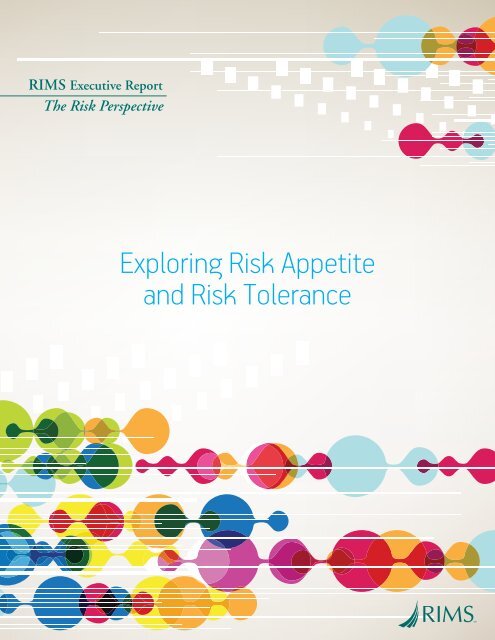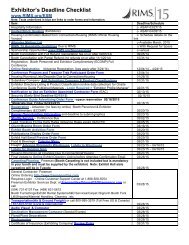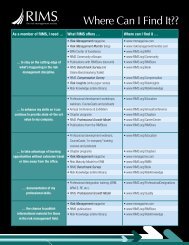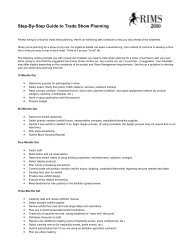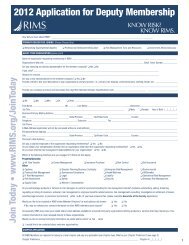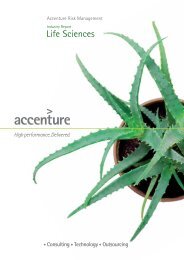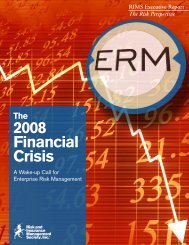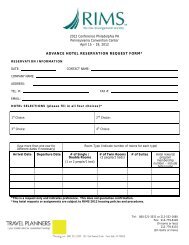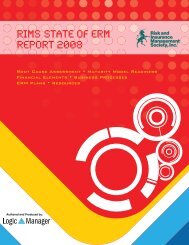Exploring Risk Appetite and Risk Tolerance - RIMS
Exploring Risk Appetite and Risk Tolerance - RIMS
Exploring Risk Appetite and Risk Tolerance - RIMS
Create successful ePaper yourself
Turn your PDF publications into a flip-book with our unique Google optimized e-Paper software.
<strong>RIMS</strong> Executive ReportThe <strong>Risk</strong> Perspective<strong>Exploring</strong> <strong>Risk</strong> <strong>Appetite</strong><strong>and</strong> <strong>Risk</strong> <strong>Tolerance</strong>
ContributorsGrace CricketteChief <strong>Risk</strong> Officer, University of CaliforniaRadu DemianManager, Corporate <strong>Risk</strong> Management, University HospitalsCarol FoxDirector of Strategic <strong>and</strong> Enterprise <strong>Risk</strong> Practice, <strong>RIMS</strong>John Hach<strong>Risk</strong> Manager, Lincoln ElectricJoanna MakomaskiVice President <strong>and</strong> Chief <strong>Risk</strong> Officer, HealthNow New York Inc.Rupak MazumdarSenior Manager, Enterprise <strong>Risk</strong> Management, George Weston LimitedRussell McGuireDirector, Enterprise <strong>Risk</strong> Services, <strong>Risk</strong>onnect, Inc.Morgan O’RourkeEditorKaren ArbasettiDesigner<strong>RIMS</strong> is a global not-for-profit organization representing more than3,500 industrial, service, nonprofit, charitable <strong>and</strong> government entitiesthroughout the world. Dedicated to advancing risk managementfor organizational success, <strong>RIMS</strong> brings networking, professional development<strong>and</strong> education opportunities to its membership of morethan 10,000 risk management professionals who operate in morethan 120 countries. For more information, visit www.<strong>RIMS</strong>.org1 | <strong>RIMS</strong> Executive Report
IntroductionEnterprise risk management (ERM) has become a critical practice in organizationsthat are dedicated to managing uncertainty <strong>and</strong> its effect on achievingorganizational objectives. ERM helps organizations focus on the mostrelevant risks to achieving an organization’s goals <strong>and</strong> objectives, both froman operational, as well as a strategic, perspective. In this way, risk is linkedinextricably with future outcomes. As noted in a November 2011 article in<strong>Risk</strong> Management Magazine entitled “Has ERM Reached a Tipping Point?,”<strong>RIMS</strong> characterizes risk as “an uncertain future outcome that can either improveor worsen our position.”How much risk an organization assumes—either knowingly or unwittingly—playsa large part in whether that uncertain future outcome actuallyimproves or worsens the organization’s position. <strong>Risk</strong> appetite <strong>and</strong> risk tolerancetherefore are critical components of an effective ERM program. The objectiveof this report is to provide those responsible for risk management with:• An underst<strong>and</strong>ing <strong>and</strong> practical applications of terms used• Practical guidance on how to explore risk appetite <strong>and</strong> tolerance withthe board of directors <strong>and</strong> executive management• Examples of risk appetite <strong>and</strong> tolerance approaches <strong>and</strong> statementsthat risk managers may be able to use or adapt for their organizations.As ERM evolves, organizations will likely advance their underst<strong>and</strong>ing, application<strong>and</strong> use of risk appetite <strong>and</strong> risk tolerance statements. <strong>RIMS</strong> intendsfor this report to provide a catalyst for discussion within individual organizations<strong>and</strong>, more broadly, among risk practitioners.<strong>Exploring</strong> <strong>Risk</strong> <strong>Appetite</strong> <strong>and</strong> <strong>Risk</strong> <strong>Tolerance</strong> | 2
Definition ChallengesSince the terms “risk appetite” <strong>and</strong> “risk tolerance” often are usedinterchangeably <strong>and</strong> different definitions abound (see “Selected Definitionsof <strong>Risk</strong> <strong>Appetite</strong> <strong>and</strong> <strong>Tolerance</strong>” below), this tends to add confusionwhen discussing the concepts both internally <strong>and</strong> externally.For the purpose of this paper, we will use the following definitions:<strong>Risk</strong> appetite is the total exposed amount that an organization wishesto undertake on the basis of risk-return trade-offs for one or moredesired <strong>and</strong> expected outcomes. As such, risk appetite is inextricablylinked with—<strong>and</strong> may vary according to—expected returns. <strong>Risk</strong>appetite statements may be expressed qualitatively <strong>and</strong>/or quantitatively<strong>and</strong> managed with respect to either an allocated individual initiative<strong>and</strong>/or in the aggregate. Think of risk appetite as the amountthat an organization actively ventures in pursuit of rewards—alsoknown as its goals <strong>and</strong> objectives.<strong>Risk</strong> tolerance is the amount of uncertainty an organization is preparedto accept in total or more narrowly within a certain businessunit, a particular risk category or for a specific initiative. Expressedin quantitative terms that can be monitored, risk tolerance often iscommunicated in terms of acceptable or unacceptable outcomesor as limited levels of risk. <strong>Risk</strong> tolerance statements identify thespecific minimum <strong>and</strong> maximum levels beyond which the organizationis unwilling to lose. The range of deviation within the expressedboundaries would be bearable. However, exceeding the organization’sestablished risk tolerance level not only may imperil its overallstrategy <strong>and</strong> objectives, in the aggregate doing so may threaten itsvery survival. This can be due to the consequences in terms of cost,disruption to objectives or in reputation impact.<strong>Risk</strong> appetite <strong>and</strong> tolerance are generally set by the board <strong>and</strong>/orexecutive management <strong>and</strong> are linked with the company’s strategy.They capture the organizational philosophy desired by the board formanaging <strong>and</strong> taking risks, help frame <strong>and</strong> define the organization’sexpected risk culture <strong>and</strong> guide overall resource allocation.<strong>Risk</strong> culture consists of the norms <strong>and</strong> traditions of behavior of individuals<strong>and</strong> of groups within an organization that determine the wayin which they identify, underst<strong>and</strong>, discuss <strong>and</strong> act on the risk theorganization confronts <strong>and</strong> takes. Organizations get in trouble whenSelected Definitions of <strong>Risk</strong> <strong>Appetite</strong> <strong>and</strong> <strong>Risk</strong> <strong>Tolerance</strong>Source <strong>Risk</strong> appetite definition <strong>Risk</strong> tolerance definitionISO Guide 73:2009 <strong>Risk</strong> managementvocabularyCOSO Strengthening Enterprise <strong>Risk</strong>Management for Strategic Advantage, 2009BS 31100:2008Amount <strong>and</strong> type of risk that an organization iswilling to pursue or retain.Note: ISO 31000 does not include this risk appetitedefinition in the guidance st<strong>and</strong>ard.A broad-based description of the desired levelof risk that an entity will take in pursuit of itsmission.The amount <strong>and</strong> type of risk than an organizationis prepared to seek, accept or tolerate.Organization’s or stakeholder’s readiness tobear the risk after risk treatment in order toachieve its objectives.Note: <strong>Risk</strong> tolerance can be influenced by legalor regulatory requirements.Reflects the acceptable variation in outcomesrelated to specific performance measureslinked to objectives the entity seeks to achieve.The organization’s readiness to bear the riskafter risk treatments in order to achieve itsobjectives.KPMG Underst<strong>and</strong>ing <strong>and</strong> articulating riskappetite, 2009Towers Perrin, What’s Your <strong>Risk</strong> <strong>Appetite</strong>,Emphasis 2009 by J. David Dean <strong>and</strong> AndrewF. GiffinECIIA <strong>and</strong> FERMA, Guidance on the 8th EUCompany Law Directive, article 42, 20113 | <strong>RIMS</strong> Executive ReportThe amount of risk, on a broad level, that anorganization is willing to take on in pursuit ofvalue.The amount of total risk exposure that an organizationis willing to accept or retain on thebasis of risk-reward trade-offs:• Reflective of strategy, risk strategies<strong>and</strong> stakeholder expectations• Set <strong>and</strong> endorsed by board of directorsthrough discussions with managementThe level of risk that the company is willing totake: high return-high risk; low risk-low return,or a portfolio of different exposures. <strong>Risk</strong> appetiteis strategic <strong>and</strong> relates primarily to thebusiness model.Note: <strong>Risk</strong> tolerance can be limited by legal orregulatory requirements.<strong>Risk</strong> thresholds, or risk tolerances, are the typicalmeasures of risk used to monitor exposurecompared with the stated risk appetite.The amount of risk an organization is willing toaccept in the aggregate (or occasionally withina certain business unit or for a specific riskcategory):• Expressed in quantitative terms thatcan be monitored• Often expressed in acceptable/unacceptable outcomes or levels of riskThe maximum amount of risk that the companycan bear despite controls. <strong>Risk</strong> tolerance ismore operational <strong>and</strong> relates primarily to thecompany’s targets.
individuals, knowingly or unknowingly, act outside of the expectedrisk culture, or when the expected risk culture either is not well understoodor enforced.A Balancing Act<strong>Risk</strong> appetite <strong>and</strong> tolerance definitions often can be a balancing actas an organization’s stakeholders may have varying philosophies onhow much risk should be pursued or retained. <strong>Risk</strong> appetite <strong>and</strong>tolerance are influenced by the nature of the organization <strong>and</strong> bythe industry that an organization operates in:• Companies with higher risk appetite generally are more focusedon the potential for a significant increase in value <strong>and</strong>earnings. As a result, these companies may be willing to accepthigher risk in return. Early-stage, high-potential, high-risk,growth startup companies have a high appetite for risk <strong>and</strong> areusually willing to accept greater volatility <strong>and</strong> uncertainty.• Conversely, companies with lower risk appetite generally aremore risk averse as their focus is on stable growth <strong>and</strong> earnings.They may be more averse to market fluctuations <strong>and</strong>greatly influenced by legal <strong>and</strong> regulatory requirements.Some definitions distinguish between appetite <strong>and</strong> tolerance inthat appetite is viewed as a statement that defines the organizationalphilosophy for managing <strong>and</strong> taking risk <strong>and</strong> tolerance as a quantitativemetric in order to bound activities <strong>and</strong> consequences within themetric. Therefore, an organization’s risk appetite must be alignedwith its risk tolerances.<strong>Risk</strong> tolerance can be measured as an acceptable/unacceptablerange of variation relative to the achievement of a specific objectiveor to the aggregated risk appetite. <strong>Risk</strong> tolerance provides constraintsaround the level of risk, which may have upper boundaries(e.g., tolerate no more than) <strong>and</strong> lower boundaries (e.g., tolerate ata minimum or not tolerate a return less than x based on the risk assumed).It may be measured using the same units as the related objective.These risk tolerances may be accompanied by a risk target.A risk target is a desired level of risk that the organization believes isoptimal to meet its objectives. This often can be some level within therisk tolerance boundaries, possibly depicted along a risk/reward curve.Implicit in the risk tolerance <strong>and</strong> risk target concepts are reviews todetermine the suitability, adequacy <strong>and</strong> effectiveness in operatingwithin the boundaries at the desired target levels. Monitoring changesfrom the expected outcomes is vital for risk tolerance statements tobe meaningful. Unexpected or unacceptable deviations should triggerfurther analysis <strong>and</strong> action, including escalation to senior management.As with appetite, an organization’s risk tolerance generally isdriven by its objectives <strong>and</strong> stakeholder expectations, ranging fromvalue protection (generally lower tolerance levels) to value creation(generally higher tolerance levels). <strong>Tolerance</strong>s are also highly dependenton how well capitalized or financed the organization is.An organization should not define risk appetite without consideringits risk capacity. <strong>Risk</strong> capacity is the amount of risk an organizationcan actually bear. An organization’s board <strong>and</strong> managementmay have a high risk appetite but not have enough capacityto h<strong>and</strong>le a risk’s potential volatility or impact. Conversely, the riskcapacity may be high but the company may decide based on strategy,management objectives <strong>and</strong> stakeholder expectations to adopta lower risk appetite.Underst<strong>and</strong>ing Your Organization’s <strong>Risk</strong> <strong>Appetite</strong>Implementation of an effective ERM program is incomplete withoutdetermining <strong>and</strong> defining an organization’s risk appetite <strong>and</strong> risk tolerance.In fact, according to the <strong>RIMS</strong> <strong>Risk</strong> Maturity Model, “riskappetite management” is one of seven essential attributes of an effectiveERM framework <strong>and</strong> an essential part of any risk-mature organization(Figure 1). Maturity is further determined by the degreeof underst<strong>and</strong>ing <strong>and</strong> accountability of five factors:• Defining acceptable boundaries• Calculating <strong>and</strong> articulating tolerance• Developing risk portfolio views• Making risk <strong>and</strong> reward trade-offs in daily management• Attacking gaps between perceived <strong>and</strong> actual risksClearly-expressed risk appetite <strong>and</strong> tolerance statements help protectorganizations against solely pursuing single, narrow goals withoutconsidering potential consequences as they pursue rewards foran “appropriate” level of risk. What is appropriate <strong>and</strong> acceptable forone organization may be unacceptable to another, as their attitudestoward risk necessarily may range along a continuum from risk takingto risk averse.<strong>Risk</strong> attitude is the organization’s or individuals’ view/perspectiveof the perceived qualitative <strong>and</strong> quantitative value that maybe gained in comparison to the related potential loss or losses. ForFigure 1: Essential Attributes of an Effective ERM Framework• ERM-based approach• Process management• <strong>Risk</strong> appetite management• Root cause discipline• Uncovering risks• Performance management• Business resiliency <strong>and</strong> sustainabilitySource: <strong>RIMS</strong> <strong>Risk</strong> Maturity Model<strong>Exploring</strong> <strong>Risk</strong> <strong>Appetite</strong> <strong>and</strong> <strong>Risk</strong> <strong>Tolerance</strong> | 4
example, many people who place their money at risk in gamblingperceive that the small (quantifiable) average financial loss combinedwith the qualitative excitement benefit is a net gain. Withinlarge, complex organizations, you may find a wide range of risk attitudesamong different business units. While risk appetite <strong>and</strong> tolerancestatements are intended to provide specific guidance, riskattitudes reflect a broader philosophy <strong>and</strong> approach that is informedby the underlying culture, beliefs <strong>and</strong> collective comfort level of theindividuals within the organization as well as external stakeholders.<strong>Risk</strong> attitudes also will vary among individual managers <strong>and</strong> boardmembers themselves. Research conducted by the Strategic DecisionGroup consistently reveals that the maximum loss variance maybe as little as .01% at a department level <strong>and</strong> as much as 17% at acorporate <strong>and</strong> board level, given the same level of expected reward.On a personal level, you may have a large appetite—some mighteven have an insatiable appetite—for the possibility of generating severalmillion dollars within your personal financial portfolio, but generallythere is a limit on what you can actually tolerate as an investment. Whatmight be some of those constraints? Your income level, the need to paythe mortgage, tuition <strong>and</strong> taxes are a few that come to mind. How theseconstraints affect your readiness to bear the risk in order to achieve themulti-million dollar objective play into your personal risk tolerance. Thisis not so different from an organizational view.Figure 2: Common Methods for Expressing <strong>Risk</strong> <strong>Appetite</strong>1. Setting a boundary on a probability <strong>and</strong> impact grid2. Economic capital measures/balance sheet-basedexpressions3. Changes in credit ratings (headroom before a potentialdowngrade)4. Profit <strong>and</strong> loss measures (e.g., tolerable level of annualloss)5. Value based measures (based on probability of ruin ordefault)6. Limits/targets or thresholds for key indicators (e.g., +/-5% variation in profit or 1 - 2.5% variation in revenue)7. Qualitative statements (e.g., zero tolerance for regulatorybreaches or loss of life)Source: Research into the definition <strong>and</strong> application of the concept of risk appetite.Undertaken by Marsh <strong>and</strong> University of Nottingham, June 20095 | <strong>RIMS</strong> Executive ReportDefining Acceptable BoundariesThe financial crisis of the late 2000s contained many examplesof organizations that either knowingly or unwittingly acceptedlarge amounts of risk in the pursuit of apparent short term gains.These organizations took risks that contributed to severe financialconsequences. In hindsight, many of these organizations had notestablished acceptable boundaries effectively nor defined a wellarticulated,properly-communicated <strong>and</strong> enforced risk appetite.Organizations that did define their risk appetite <strong>and</strong> risk toleranceapparently did not communicate or enforce the limits across theirorganizations. Moreover, they had no apparent mechanism to viewthe impact of the individual risk taking at an enterprise-wide levelor as a portfolio. Some did not have the appropriate governancemechanisms to ensure that risk takers were complying with the organization’sdefined risk appetite <strong>and</strong> tolerance. Since the financialcrisis, a strong interest has developed among board members toincrease the risk management discussions at board meetings. <strong>Risk</strong>appetite, no doubt, should play a key role in those discussions. Ideally,management <strong>and</strong> board members can agree on the acceptableboundaries for the organization.Challenges in Calculating <strong>and</strong> Articulating<strong>Risk</strong> <strong>Appetite</strong> <strong>and</strong> <strong>Tolerance</strong>Defining, determining, calculating <strong>and</strong> articulating both risk appetite <strong>and</strong>tolerance is challenging. There are many reasons for these challenges:• There are varying definitions for these terms. Indeed, risk appetite<strong>and</strong> tolerance often are used interchangeably.• <strong>Risk</strong> appetite is described using multiple methods <strong>and</strong> differentcalculations (Figure 2). Some organizations take a qualitativeapproach to risk appetite with categories such as high,moderate or low, while others take a quantitative approach,such as value at risk (with metrics like economic value at risk<strong>and</strong>/or financial strength at risk) <strong>and</strong> earnings at risk (withmetrics like EPS at risk or amount of loss a company is willingto accept).• Few detailed examples have been published that articulaterisk appetite <strong>and</strong> tolerance. Organizations that have definedrisk appetite <strong>and</strong> tolerance statements often are sensitiveabout sharing their methodologies with the larger community.Developing <strong>Risk</strong> Portfolio ViewsSome organizations use specific risk appetite <strong>and</strong> tolerance statementsbased on certain categories of risk. Other organizations approach riskstatements with overall organizational statements, such as:• Take risks that the organization can manage in order to optimizereturns• Balance risk <strong>and</strong> reward against the impact <strong>and</strong> cost of managingrisks for the organization• Accept potential loss of x% of [EBIT/earnings/donations] for a50% probability of increasing [EBIT/earnings/donations] by x%• Avoid risks that negatively impact br<strong>and</strong>While these types of statements may provide guidance, they do notconsider the impact on the overall risk position for the organization.They also do not address the question as to whether the organizationis taking enough risk to sustain itself.
Figure 3: The Efficient FrontierFigure 4: Applying the Efficient Frontier for <strong>Risk</strong> TakingA portfolio above thiscurve is impossibleHigh <strong>Risk</strong>/High ReturnOptimal portfoliosshould lie on thiscurve (known asthe “efficientfrontier”)Efficient FrontierNReturn %Medium <strong>Risk</strong>/Medium ReturnLow <strong>Risk</strong>/Low ReturnPortfolios below the curve arenot efficient, because for thesame risk one could achievegreater returns.Expected Return (%)Allocated EquityCapital rebalancing targetABOptimalportfolioZone of possiblerisk portfoliosCurrentportfolio<strong>Risk</strong> (volatility)<strong>Risk</strong> % (St<strong>and</strong>ard Deviation)Adapted from work by J.P. Louisot. Used with permission.Consider how a portfolio risk appetite <strong>and</strong> tolerance view may beexpressed using an “efficient frontier” lens (Figure 3). Efficient frontierapproaches have been used extensively in financial institutionsto calculate the optimal risk/reward balance (or ratio) for securities<strong>and</strong> investments, based on the Modern Portfolio Theory developedby Harry Markowitz in the 1950s. Different combinations of investmentsproduce different levels of return based on the level of risk assumed.The efficient frontier represents the best of these investmentcombinations—those that produce the maximum expected returnfor a given level of risk. Such an approach lends itself to situationswhere risks <strong>and</strong> rewards are financial in nature.A number of nonfinancial organizations are beginning to use efficientfrontier models to allocate capital in a way that enables thehighest return for an acceptable level of risk across the organization(Figure 4). In this illustration, an organization may be willing to assumea greater level of risk <strong>and</strong> volatility in order to obtain a higherexpected return (optimal portfolio) than currently realized from divisionsA <strong>and</strong> B (current portfolio). As such, it reallocates targetedcapital to division N along the efficient frontier to rebalance the entireportfolio more efficiently. Obviously, there are many assumptionsthat underlie this model, but it is based fundamentally on the organizationincreasing its overall risk appetite to achieve a greater return.This type of approach can help answer the question as to whethermanagement should be taking on more or less risk.Making <strong>Risk</strong> <strong>and</strong> Reward Trade-Offs in Daily Management<strong>Risk</strong> appetite <strong>and</strong> tolerance statements are meaningless if they arenot translated <strong>and</strong> communicated into daily management decisions.Senior executives may go to the trouble of developing risk appetite<strong>and</strong> tolerance statements that are approved at the board level.These statements may even be cascaded or distributed to operatingmanagers.How these statements are used for guiding daily risk <strong>and</strong> rewardtrade-offs makes all the difference, however. Impact scales canbe determined per project, aggregated per operational or businessunit <strong>and</strong> then confirmed at the corporate level. In this way, therisks arising from projects are in compliance with the company’soverall risk appetite.Consider how a manufacturing firm might apply this concept to aan operating unit undertaking a new strategic project valued at $100million in investment. At the outset, management defines the impact<strong>and</strong> likelihood levels to be considered as noted in the table below:Impact Level Likelihood50% or $50M Very High 90%25% or $25M High 30%12.5% or $12.5M Medium 10%6.25% or $6.25M Low 3%Below $6.25M Very Low Below 3%So using these parameters, how can risk appetite <strong>and</strong> tolerancestatements be translated into daily management?Management determines at what point a project can be shutdown. As the project is valued at $100 million in investment, a lossof 50% of the project value is considered a very high impact. Inother cases, the percentage may vary based on type of industry,strategic position on the market, etc. If the likelihood of the $50million impact is determined to be below 3%, it may be acceptablebut not if the likelihood reaches 10%.Assume the company defines its key risk indicators (KRIs) undervarious areas that can cause an impact to the project or tothe company’s operations overall. In this example, the areas are:Strategic, Finance, Legal, Operations, Compliance <strong>and</strong> Quality.Each area has defined levels of risk that are designed to match thefinancial impact level on the impact scale above.For example, a strategic risk may be to lose access to a smallregional market. Even though this is viewed as a strategic risk, thecompany quantifies the risk financially to have an $80 million impacton revenues. Therefore, the risk is considered to have a veryhigh impact as it exceeds the $50 million threshold defined above.<strong>Exploring</strong> <strong>Risk</strong> <strong>Appetite</strong> <strong>and</strong> <strong>Risk</strong> <strong>Tolerance</strong> | 6
The company may financially quantify different types of risks underthe various areas, but may exclude certain risks from the limits set,such as employee safety risks.The company-specific KRIs are designed by a team of individualsfrom selected areas. The process is finalized by obtaining theboard <strong>and</strong> senior management’s approval of the developed risklevels <strong>and</strong> identified specific risks. Projects on an individual level<strong>and</strong> aggregated on a company level can then be monitored for deviationsagainst the expressed risk appetite <strong>and</strong> tolerances.<strong>Risk</strong>s that can affect the company’s strategic plan or influencethe strategic position would be considered through the organization’sERM process, by consolidating <strong>and</strong> using a simulation methodto determine the risk exposure for the entire company.Attacking Gaps Between Perceived <strong>and</strong> Actual <strong>Risk</strong>sSometimes organizations are overwhelmed with the prospect ofdealing with the multitude of risks that can be identified, some ofwhich are “perceived” <strong>and</strong> some “real.” What needs to be takeninto consideration to differentiate between perceived risks <strong>and</strong> actualrisks? First, a formal mechanism needs to be established. Thenext step is to attack the gaps between the risks that matter to theorganization’s objectives <strong>and</strong> those that do not.To determine whether an identified risk actually matters to theorganization, ask whether the risk is both relevant <strong>and</strong> important toachieving the organization’s objectives. That is, can the risk eitherimprove or worsen the organization’s position? If the answer is no,the risk may be a perceived rather than an actual risk <strong>and</strong> may beput aside for later consideration as circumstances change. This isnot to say that perceived risks are not real risks. Indeed, they maywarrant attention one day, so they should not be forgotten.Four questions then can be asked in relation to the organization’srisk appetite for the remaining risks:1. Is this risk within an acceptable range based on the organization’srisk appetite <strong>and</strong> tolerance levels?2. If yes, is there a way to exploit this risk in order to create orcapture more value for the organization?3. If not, what is the most the organization would reasonablyexpend in resources, investments <strong>and</strong> controls to bring therisk into acceptable boundaries? In order to keep consequenceswithin a tolerable <strong>and</strong> justifiable level, the organizationneeds to consider the cost (financial or otherwise) ofconstraining the risk within acceptable parameters shouldthe uncertain outcome become a reality. Control costs thatare out of balance with the organization’s overall risk attitudegenerally are neither efficient nor optimal.4. What monitoring mechanisms can be used to trigger actionif there are deviations from expected outcomes or inadvance of crossing risk tolerance targets?In this way, managers can report on the organization’s actual assessedrisk as compared to the organization’s defined risk appetite<strong>and</strong> tolerances, whether at a corporate, operational or project level.Management then can execute plans that incorporate activities toreduce unfavorable variations <strong>and</strong> accelerate favorable variations.Considering Potential Unintended ConsequencesYou may have read statements like, “the business has zero appetite(or tolerance) for fraudulent activity” or “the business haszero tolerance for outages beyond x time in duration.” Translatedinto daily management, these statements potentially may result ina manager firing an employee for dishonesty, whether the dishonestyresulted in a $1 or a $1 million loss, or in establishing a fullyredundant operations center with capacity to h<strong>and</strong>le all businesstransactions.Typically, the potential costs associated with complying withthese statements are not considered when they are developed.The employee whose dishonesty resulted in the $1 loss may representa $100,000 training investment, or be the engineer withthe latest technological know-how to advance the organization’score business. Building a fully redundant operations center maybe impracticable or the costs may be grossly disproportionate tothe disruptive time frame.That is not to say that zero tolerance statements are unwarrantedor unmanageable. It is, however, important to underst<strong>and</strong> the potentialimplications when adopting or modifying such statements.Stakeholders <strong>and</strong> <strong>Risk</strong> <strong>Appetite</strong>Although decisions about risk appetite <strong>and</strong> risk tolerance levels generallyfall to an organization’s executive management team <strong>and</strong> board toshape, ISO Guide 73:2009 notes that stakeholders also have a “willingnessto bear risk.” The internal <strong>and</strong> external context within whichorganizations operate can hold a tremendous sway on an organization’sapproach to its risk appetite <strong>and</strong> tolerance statements (Figure5, page 8).In addition to the strategies <strong>and</strong> objectives driven by the organization’sboard <strong>and</strong> management risk attitudes, its other internal<strong>and</strong> external stakeholders hold varying attitudes about the level oramount of risk an organization should assume. The varying riskattitudes of these organizations <strong>and</strong> individuals when comparedwith the organization’s own risk attitude can become problematicif the organization is not clear in its own statements, transparentlysignaling to its varied stakeholders what can be expected as theorganization pursues its objectives.Underst<strong>and</strong>ing the varying risk attitudes of the organization’s external<strong>and</strong> internal stakeholders may influence how the organizationbalances its risk appetite statements with the expectations ofthese stakeholders.Case StudiesThis report provides four examples of organizations that have definedor are working toward their risk appetite <strong>and</strong> tolerance statements.These are presented so that risk practitioners can consider7 | <strong>RIMS</strong> Executive Report
Figure 6: Depiction of a Health Care Organization’s <strong>Risk</strong> PositionExpectedOutcome<strong>Risk</strong> Position<strong>Tolerance</strong><strong>Appetite</strong>“Black Swan”Maximum<strong>Tolerance</strong><strong>Tolerance</strong>Limit<strong>Appetite</strong>LimitMaximum<strong>Appetite</strong>“Golden Goose”“<strong>Risk</strong> appetite is the amount <strong>and</strong> type of risk that [the organization]regards as appropriate for it to accept in order to execute itsstrategy. The board regularly reviews <strong>and</strong> sets this in the form of 10risk appetite statements, which it sets in the context of [the organization’s]strategy <strong>and</strong> the requirements of various stakeholders,including the regulatory framework in which we operate.”The risk appetite statements provide the benchmark against whichthe company’s risk profile is reported, monitored <strong>and</strong> managed bythe board, audit <strong>and</strong> risk, finance, <strong>and</strong> risk assurance committees.<strong>Risk</strong> appetite also forms the basis for the calibration <strong>and</strong> setting ofthe delegated authorities <strong>and</strong> financial limits for all aspects of market,credit, liquidity <strong>and</strong> operational risk. The 10 risk appetite statementsaddress both quantitative <strong>and</strong> qualitative aspects of risk taking.The quantitative risk appetite statements address:• maximum tolerance for market, credit <strong>and</strong> operational losses• the maintenance of a minimum credit rating level• minimum economic <strong>and</strong> regulatory capital surpluses• the maximum earnings volatility• minimum excess liquidity resources to meet peak stressedliquidity requirements without the need to liquidate assetsor raise capitalThe qualitative risk appetite statements address:• regulatory risk• reputation risk• business m<strong>and</strong>ate• operational risks in the execution of business plans• risk-related decision making, especially in relation to newbusiness opportunitiesThe statements express the organization’s risk-taking approach forits internal <strong>and</strong> external stakeholders. The statements paint a “portfolio”view of the organization’s willingness to bear <strong>and</strong> pursue riskfor an expected return. It represents a collection not only of the risktypes related to the business portfolio (qualitative statements) butof its overall enterprise financial appetite (quantitative statements).What is not clear—looking only at the statements themselves—ishow these risks relate to each other within the organization’s overallrisk portfolio. The public statements of the company do not indicatewhether this particular organization uses an efficient frontier modelto consider the interrelatedness of its risk/return decisions in a portfolioview. However, it may be safe to assume that at least some portionsof its risk portfolio are considered in this way.Case 3: Toy Manufacturer Makes <strong>Risk</strong>/RewardTrade-Offs in Daily ManagementConsider a very successful <strong>and</strong> innovative toy manufacturing company.This example highlights two high-level organizational risk appetitestatements that are then used for decision making, whetherin general for the company or as applied in particular for eachproject.<strong>Appetite</strong> Statement Part 1:The company will not accept any risks that will be a “High <strong>Risk</strong>”after mitigation.The company is willing to bear or retain risks that are assessed asmedium or low after mitigation in pursuit of its objectives. In thisway, risk appetite is tied to the traditional risk map <strong>and</strong> the variabilityaround earning levels. It is adaptable in that—based on howrisk is characterized within the organization’s earnings at any particulartime—it can reflect either a higher risk appetite (Figure 7,page 10) or a lower risk appetite (Figure 8, page 10) as describedmore fully below.In this example, three risk priorities levels (High, Medium <strong>and</strong> Low)were determined when creating the risk map. Figure 7 reflects a relativelygreater willingness to accept risk in pursuit of the organization’smission <strong>and</strong> objectives. The actual risk appetite can be modified basedon the company’s determination of “High <strong>Risk</strong>.” If circumstanceschange <strong>and</strong> it prefers to adopt a lower risk appetite, it can designate9 | <strong>RIMS</strong> Executive Report
“High <strong>Risk</strong>” to encompass lower impact levels as shown in Figure 8.However, this does not change the risk appetite statement itself.<strong>Appetite</strong> Statement Part 2:The company shall ensure that it materializes at least [x%] ofthe budgeted earnings at a 95% confidence level.Suppose the company wants to be 95% certain that earnings exceed$160 million. If budgeted earnings are set at $200 million, managementdetermines that the acceptable lower range limit (or boundary)is 20% of budgeted earnings, that is, $40 million. Therefore, if actualearnings are above $160 million in 19 out of 20 quarters, they willhave met their objective.To arrive at this situation, the company looks at the assumptionsused in calculating the budgeted earnings as well as its risk portfolio<strong>and</strong> determines through simulations that the worst case scenarioat the 95th percentile is an acceptable value of 20% below budget(that is, all but 5% of the scenarios result in budgeted earnings of atleast $160 million). This means that all things being equal, only oncein 20 quarters will the actual earnings be less than $160 million. Inthis process, management has determined that up to a 20% “miss”on earnings is acceptable, i.e., within its risk tolerance range.The major benefit of defining the risk appetite in this way is that theboard <strong>and</strong> senior management underst<strong>and</strong> the methodology <strong>and</strong> calculationsenough to trust it. There are certain occasions when senior managementor the board asks whether the company is taking enough risk<strong>and</strong> what would happen if they accept more risk? The solution would beFigure 7: Higher <strong>Risk</strong> <strong>Appetite</strong>Figure 8: Lower <strong>Risk</strong> <strong>Appetite</strong>ImpactImpactLikelihoodLikelihoodHigh <strong>Risk</strong>Medium <strong>Risk</strong>Low <strong>Risk</strong>High <strong>Risk</strong>: Medium to VeryHigh Impact <strong>and</strong> Low toVery High LikelihoodMedium <strong>Risk</strong>: Very Low toVery High Impact <strong>and</strong> VeryLow to Very High LikelihoodLow <strong>Risk</strong>: Very Low to MediumImpact <strong>and</strong> Very Low to VeryHigh LikelihoodHigh <strong>Risk</strong>Medium <strong>Risk</strong>Low <strong>Risk</strong>High <strong>Risk</strong>: Medium High <strong>Risk</strong>: to Very Low to Very HighHigh Impact Impact <strong>and</strong> Low <strong>and</strong> to Very Low to VeryVery High Likelihood High LikelihoodMedium <strong>Risk</strong>: Medium Very Low <strong>Risk</strong>: to Very Low to HighVery High Impact <strong>and</strong> Very Low to VeryLow to Very High LikelihoodLow <strong>Risk</strong>: Very Low Low <strong>Risk</strong>: to Very Medium Low to MediumImpact <strong>and</strong> Impact Very Low <strong>and</strong> to Very Low to VeryHigh Likelihood High Likelihood<strong>Exploring</strong> <strong>Risk</strong> <strong>Appetite</strong> <strong>and</strong> <strong>Risk</strong> <strong>Tolerance</strong> | 10
to compare the utilized risk capacity with the available risk capacity. Ifthe company is far from utilizing the full extent of it, solutions involvingbeing more aggressive <strong>and</strong> taking more risks are considered. In anysituation, the available risk capacity will not be exceeded <strong>and</strong> consideringthe risk appetite, will be better utilized. Using a driving analogy, thecondition of your vehicle may determine that you can safely drive 50mph (available capacity). If you are currently doing 35 mph (utilizedcapacity), you may decide to go faster, as long as you do not exceed50 mph.Case 4: University System Calculates <strong>and</strong> ArticulatesIts <strong>Risk</strong> <strong>Appetite</strong> <strong>and</strong> <strong>Tolerance</strong> LevelsConsider the case of a major university system comprised of multiplecampuses, medical centers, research operations, student activities<strong>and</strong> housing, international facilities <strong>and</strong> programs, <strong>and</strong> allthat it entails. Two key questions need to be answered:1. How should the appetite for any particular risk be determined<strong>and</strong> what should be measured?2. What metrics should be used to measure whether the riskis within expected tolerance levels?One risk appetite statement <strong>and</strong> one set of metrics obviously would notserve the multiple stakeholders represented by the university system’senvironment. If set too low, a single risk appetite statement may be constraining.If set too high, it would provide little or no guidance to a numberof the system constituencies. Ideally, the statements would provide:• Measures that reveal when deviations from expected outcomesare reaching or breaching the risk tolerance limitsfor each type of risk. Awareness <strong>and</strong> monitoring of establishedthresholds would help this organization track changesin risks <strong>and</strong> avoid unexpected consequences.• <strong>Risk</strong> targets that are the ideal goal for the risk based on theorganization’s objectives, risk appetite statements <strong>and</strong> measuresfor each risk.• <strong>Risk</strong> tolerance/range where risk would be allowed to deviatearound the defined risk target. This ensures that definedrisk tolerances fall within the organization’s risk capacity. Theuniversity’s board of regents <strong>and</strong> management may establisha fairly high risk appetite, but the system may not haveenough capacity to h<strong>and</strong>le a risk’s potential volatility or impactover the breadth of the university system’s operations.In order to manage within this environment, a system-wide teamhas explored a number of complementary approaches:• Combine the system’s already established key performanceindicators with the appetite <strong>and</strong> tolerance levels.• Allow the campuses to set their own thresholds based on asystem-wide tolerance statement.• Use the already established enterprise risk management informationsystem dashboards for communicating levels <strong>and</strong>reporting deviations from the expected outcome.Figure 9 below does not reflect actual statements created by theuniversity system, but represents what could be potential outcomesusing the described approach.Figure 9: Possible University System <strong>Risk</strong> <strong>Appetite</strong> <strong>and</strong> <strong>Risk</strong> <strong>Tolerance</strong> StatementsPerformanceCriteriaPotential <strong>Risk</strong><strong>Appetite</strong> StatementPotential <strong>Risk</strong>TargetPotential <strong>Risk</strong><strong>Tolerance</strong> StatementPotential MetricsorKey <strong>Risk</strong> Indicators• Debt service-to-operationspercentage• Allocation of debtservice• Employee turnover bylocation or operating unit• Deviations from establishedsystem-widetolerance limit• Aggregated comparativeto potential risk target• Variations from ratingagency expectations• Deviations from cost ofborrowing assumptions• Deviations in amountsDebt ServiceThe university system iswilling to assume x% of itssystem-wide operationalrevenues for debt service.Derived number based onappetite statementNo more than x% of thetotal debt service can applyto any one initiative (orcampus or project).Employee TurnoverThe university system acceptsan investment of $xper headcount in recruiting<strong>and</strong> training for newemployees.Calculated number basedon appetite statementOn a university-wide basis,employee turnover is to beless than x% in any given90-day period.Cost of BorrowingThe university system is willingto assume credit interestrates of x% for borrowing[a certain dollar amount orpercentage of assets] tofund new initiatives.Expected cost of borrowingnumberCredit rating may not dropmore than one grade fromits current level.11 | <strong>RIMS</strong> Executive Report
ConclusionThere are certain key elements to keep in mind when establishingyour organization’s risk appetite <strong>and</strong> tolerance:Underst<strong>and</strong> the concepts: Clearly articulating risk appetite <strong>and</strong> toleranceare key for a well-developed <strong>and</strong> effective enterprise riskmanagement strategy. Board <strong>and</strong> top management underst<strong>and</strong>ingof the risk appetite <strong>and</strong> tolerance concepts, as well as how criticaltheir statements are for achieving strategic objectives, are foundational.Without overcoming this initial challenge, proceeding furtherin attempting to articulate risk appetite <strong>and</strong> tolerance is destinedfor failure.Balance risk <strong>and</strong> reward: Beyond gaining support for a well-developedunderst<strong>and</strong>ing of risk appetite, the challenge in articulatingan effective risk appetite is in balancing the risk/reward trade-offto provide a sustainable, long-term result. It can be undesirable<strong>and</strong> costly to attempt to eliminate all risk in an organization or toconversely not set upper limits. If the risk appetite is too low or isnever challenged operationally, the potential for reward will likelybe low (unless it is a niche market or monopoly). If risk appetiteis too high or not understood by the board, management <strong>and</strong>employees, it can have extremely negative consequences on thecompany <strong>and</strong> possibly the industry. There are many examples ofthis from the recent financial crisis. Financial organizations that settheir tolerances <strong>and</strong> appetites pre-2008 found a few soft spots intheir evaluation of how much appetite <strong>and</strong> capacity they truly had<strong>and</strong> how much they needed to modify their risk appetite based onunanticipated risks or due to model risk.Use for more than financial measures: Financial results are generallythe most common components in risk appetite <strong>and</strong> tolerance. Theyare easiest to quantify <strong>and</strong> most areas eventually boil down to a financialresult. Financial metrics are an important component of riskappetite, but risk appetite needs to be expressed beyond just financialperformance metrics. Whether the stated appetites <strong>and</strong> tolerancefurther the organization’s strategic objectives is more critical than justfinancial metrics.Leverage positive aspects for taking risk: <strong>Risk</strong> can lead to bothpositive <strong>and</strong> negative results. Therefore, risk appetite should notbe looked at simply through a negative lens. Taking too little riskmay have undesirable consequences. There should be a positiveorientation to the discussion where questions such as “what riskscan provide us with the most value?” should be asked.Evolve risk position over time: Defining <strong>and</strong> articulating risk appetite<strong>and</strong> tolerance will provide little value unless the position is updated,regularly monitored <strong>and</strong> has a control system to flag whensomeone is operating outside of the defined risk tolerance. <strong>Risk</strong>appetite <strong>and</strong> risk tolerance must adapt to an organization’s everchangingrisk environment. It is important to continue to refinetolerance <strong>and</strong> appetite statements over time to stay in sync withan organization’s evolution. The company’s strategy <strong>and</strong> its riskappetite <strong>and</strong> risk tolerance work h<strong>and</strong> in h<strong>and</strong> <strong>and</strong> influence eachother. They should be designed <strong>and</strong> changed together.Communicate risk appetite <strong>and</strong> tolerance: Finally, organizations thathave developed risk appetite statements may not have communicatedthis well to stakeholders. Without proper communication ofrisk appetite levels, organizations cannot expect that employeesare consistently making decisions that are aligned to an organization’srisk appetite. The challenge is compounded by the fact thatthe organization may wish to keep some of the risk appetite measuresconfidential from public view.Well-defined <strong>and</strong> well-thought-out risk appetite <strong>and</strong> tolerance practices:• Encourage organizations to take measured risks in order togenerate value <strong>and</strong> avoid intolerable losses.• Align stakeholders (e.g., the board, senior management,shareholders) on the amount <strong>and</strong> type of risk the organizationis willing to take.• Create awareness about, <strong>and</strong> actions to prevent, excessivelevels of risk that could lead to adverse consequences.© Copyright 2012 <strong>Risk</strong> <strong>and</strong> Insurance Management Society, Inc. All rights reserved.<strong>Exploring</strong> <strong>Risk</strong> <strong>Appetite</strong> <strong>and</strong> <strong>Risk</strong> <strong>Tolerance</strong> | 12


